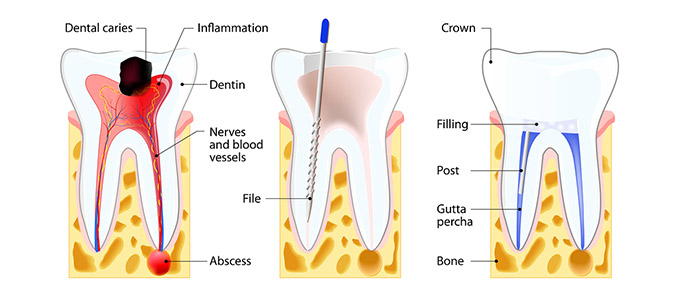All teeth have three main layers: the outer enamel layer, the inner dentin layer and the pulp. The pulp is the innermost layer within the roots of the tooth and contain the nerves and blood vessels that supply the tooth. The blood vessels provide nutrients to the tooth and the nerves provide sensation.
When the pulp is intact, the tooth is vital and healthy. When a tooth becomes decayed or fractured, the bacteria eat their way through the enamel and dentin layers until they reach the pulp tissue. Once here, they cause the pulp tissue to break down, causing destruction of the nerves and blood vessels within the pulp. As the tissue breaks down, an infectious process starts within the pulp and eventually the nerves and blood vessels die. Pressure from this infectious process builds up within the tooth, usually causing pain, and eventually an abscess develops at the root tip. Until this degraded tissue is removed from within the tooth, this painful, infectious process continues.
When root canal treatment is performed, an opening is created through the top of the tooth to gain access to the pulp. The decayed tissue and infectious debris is cleaned out of the canals using small files. Once the canals have been thoroughly cleaned and are free of bacteria, they are sealed with a filling material and usually the abscess will heal. A temporary filling is used to close the opening in the tooth until the final restoration is placed.
The process of root canal therapy has progressed significantly over the years, and is now most often a one-visit procedure. Root canal therapy is highly successful and often lasts a lifetime, although on occasion, a tooth will have to be retreated due to reinfection at a later date.
Good oral hygiene practices and regular dental visits will aid in prolonging the life of your root canal treatment. Most teeth that undergo root canal therapy require subsequent crown (cap) placement to protect the tooth from fractures and provide strength. After treatment, your tooth may still be sensitive, but this will resolve as the inflammation and irritation from the bacteria diminishes and the tooth completely heals.
Sometimes, no symptoms are present and your dentist may discover signs of an abscess at the bottom of your tooth on routine radiographs. Often, signs and symptoms for possible root canal therapy:
- An abscess (or pimple) on the gums
- Prolonged sensitivity to hot and cold
- Severe toothache pain
- Swelling and/or tenderness










